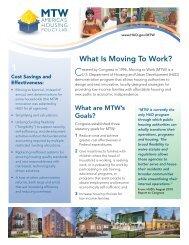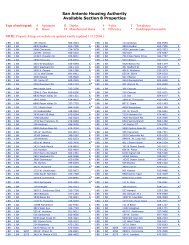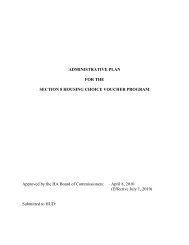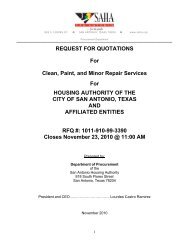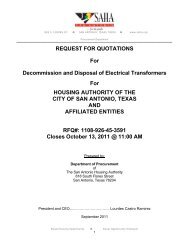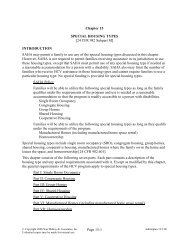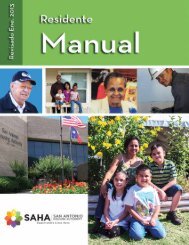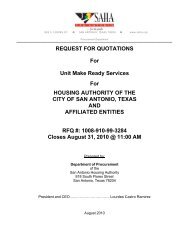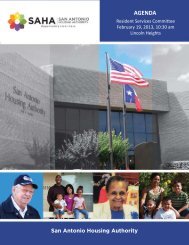AGENDA - San Antonio Housing Authority
AGENDA - San Antonio Housing Authority
AGENDA - San Antonio Housing Authority
- No tags were found...
Create successful ePaper yourself
Turn your PDF publications into a flip-book with our unique Google optimized e-Paper software.
SAN ANTONIO HOUSING AUTHORITY May 16, 2013MEMORANDUMTo:From:Presented by:RE:Operations and Human Resources CommitteeLourdes Castro Ramirez, President and CEODavid Clark, Interim Deputy Director of Public <strong>Housing</strong>Update and discussion on-line applications for Public <strong>Housing</strong> sitesSUMMARY:At last month’s Operations and Human Resources Committee meeting, the Commissionersasked a number of questions regarding the Public <strong>Housing</strong> Department’s conversion to on-lineapplications.One request involved capturing additional information regarding the number of hours the headof household works. The contractor, Cindi Herrera and Associates, is working on thesechanges. The program will ask the user to select from three ranges of hours: < 20 hours perweek; 20-30 hours per week; or > 30 hours per week.Another questions was raised about whether the preferences used in Public <strong>Housing</strong>—Involuntary Displacement and, for 200 families only, a preference for Working Families – shouldbe the same as the preferences used in the <strong>Housing</strong> Choice Voucher program, which includethose for Involuntarily Displaced, Veterans, the Disabled, and the Homeless.In SAHA’s Public <strong>Housing</strong> program, 2,782 (47%) households are families, 1,671 (28%) aredisabled, 452 (8%) are elderly but not disabled, and 1026 (17%) are elderly and disabled. ThePublic <strong>Housing</strong> waitlist is composed of 11,980 families, 540 elderly and 3,925 disabled. If thepreferences in Public <strong>Housing</strong> matched those in the Section 8 program, homeless disabledveterans would be housed before anyone else in Elderly/Disabled housing; those applicantswho are homeless and disabled, homeless veterans, and disabled veterans would be housednext. Disabled veterans comprise the largest number of applicants with any of these potentialpreferences. Any of these applicants would be housed before a non-disabled elderly person.The consequence might severely limit any provision of housing for the non-disabled elderly andchange the composition of the population served in Public <strong>Housing</strong> communities.We will add this for review during next year’s the process of Moving to Work (MTW) evaluationsand revisions. This will enable us to gather more information and to also obtain feedback fromthe MTW Advisory Committee. Changes to the plan could potentially impact our ability to furtherMTW initiatives, such as moving able-bodied adults to employment and self-sufficiency. Anadditional challenge to consider is that SAHA does not have extensive wrap-around services forspecial-needs populations. At this point, the MTW proposed plan has already been submitted toHUD for fiscal year 2013-2014.Testing of the new software for the on-line applications began on May 7, 2013, to ensure therewere no remaining glitches. The contractor assisting SAHA with the software, Cindi Herrera andAssociates, has been working with SAHA staff to develop a communications plan, to meet withcommunity stakeholders, and to orient staff.



